Cuprins
- 1. The forms of the relief as natural tourist resource.
- 2. Climate.
- 3. Hydrography.
- 4. Vegetation.
- 5. Fauna.
- 6. The Tourist Landscapes.
Extras din curs
1. The forms of the relief as natural tourist resource
Relief is the most rich and diverse attractive resource of the world. It is the core of any landscape. The importance of relief for tourism is conditioned to the great varieties of its forms.
The escarpments (steep cliffs or slopes formed by a fault or by erosion) become tourist objectives through their scale, splendor, and the vertical change of nature. Their force of attraction evolves with the relative altitude. They draw the mountaineers (alpinists, climbers).
Escarpments are often called scarps. A fault scarp is formed by a fault, which is a fracture or break in the earth’s crust, along which one side is raised and the other is forced downward. An erosion scarp is formed by the unequal erosion of gently sloping or horizontal layers of rock. Such escarpments result when underlying, softer rocks are eroded more rapidly than the upper, more resistant rocks.
A well-known fault scarp is the eastern edge of the Sierra Nevada Mountains in the western United States. A well-known erosion scarp is the Niagara escarpment in the Great Lakes region of North America. Niagara Falls is located where the Niagara River crosses the escarpment.
The crests and the peaks represent lines and points of certain sides of the mountains. The more unusual and higher the peaks are, the more their individuality grows, and the more they draw travelers’ attention.
The passes and the banks play a major part in the gathering of tourists along certain destinations. They link different regions between them. The passes intervene between the crests and the massifs. The banks are along the river systems.
The gorges, the defiles, and the canyons constitute an imposing group of natural resources. The gorges represent the first stage, the most savage, of the valleys. Sometimes their cross profile is so narrow that men’s access is very difficult, or even impossible. The defiles are more evolved gorges. The canyons represent the height of evolution of gorges. As role model is the Grand Canyon of Colorado in Arizona.
Canyon, deep, cliff-sided chasm or gorge created by the erosive action of a river. Canyons most often occur in semiarid or arid regions where river erosion deepens the canyon faster than weathering (the breakdown of rocks) of the sides can widen it. The deepest and steepest canyons develop in regions with flat-lying, alternating beds of hard and soft rock. In such circumstances, the sides of the canyon resemble a staircase, with the layers of harder rocks forming cliffs and the layers of softer rock forming gentler slopes.
Canyons are particularly abundant across large areas of Arizona and Utah in the southwestern United States where there is an optimal combination of climate and rock structure. The largest example in this region is the Grand Canyon of the Colorado River, which is 446 km (277 mi) long, more than 1500 m (5000 ft) deep, but only 29 km (18 mi) across from rim to rim at its widest. The canyon was formed in a remarkably short period of about 1 million years, around 4 million to 5 million years ago. Canyons are also found in other dry regions around the world. One of the largest examples is the Fish River Canyon in Namibia, which extends for 160 km (100 mi). This canyon is 25 km (16 mi) wide and almost 500 m (1600 ft) deep in places.
The caves (caverns) have an attractive potential thanks to their important recreational resources: their shape, varied morphology, archeological and paleontological remains, and fossil glaciers. They represent a system of evolution.
Cave is a chamber beneath the surface of the earth or in the side of a hill, cliff, or mountain. Caves vary in size and shape, and many have large openings to the surface.
Caves range in size from small hillside openings to vast interconnected subterranean systems of many chambers and galleries. Some cave systems extend for miles underground and may have many outlets.
Natural air conditioning occurs in large caverns if the temperature varies only a few degrees yearly, and the caves are more or less constantly ventilated with fresh air. These conditions are, in part, the result of complex meteorological phenomena, mainly variations in barometric pressure.
Caves formed by abrasion commonly consist of myriads of winding tunnels and former underground waterways that show many features analogous to those of surface streams, such as deposits of sand and gravel. Abrasion-formed caves normally lack the weird formations found in caves of solution.
In caves of solution, the dissolved lime carbonate is often precipitated in such a fashion as to form grotesque deposits. The best-known structures are the stalactites, which hang like icicles from the roofs of caves, and the stalagmites, which extend upward from the cavern floors (see Stalactite and Stalagmite). If the two growths meet and join, a pillar forms, helping to support the roof. Less well-known forms of carbonate deposition include flowstone and dripstone. Depending on dissolved mineral impurities brought into the cave by the groundwaters, the formations vary in color from alabaster white to hues of dusky red and brown. The dripstone formations may be exceedingly thin and translucent. Among rare formations is the helictite, a twisted, flowerlike variety of stalactite. Many cave formations are rather delicate and easily broken, and some of the best examples have been damaged or removed by unscrupulous cave explorers and visitors to public caves.
Preview document
Conținut arhivă zip
- Natural Tourist Resources.doc





























